The 2017 Mercedes-Benz E300 challenges Tesla's Autopilot with Drive Pilot
Mercedes' latest E300 can drive itself on the highway
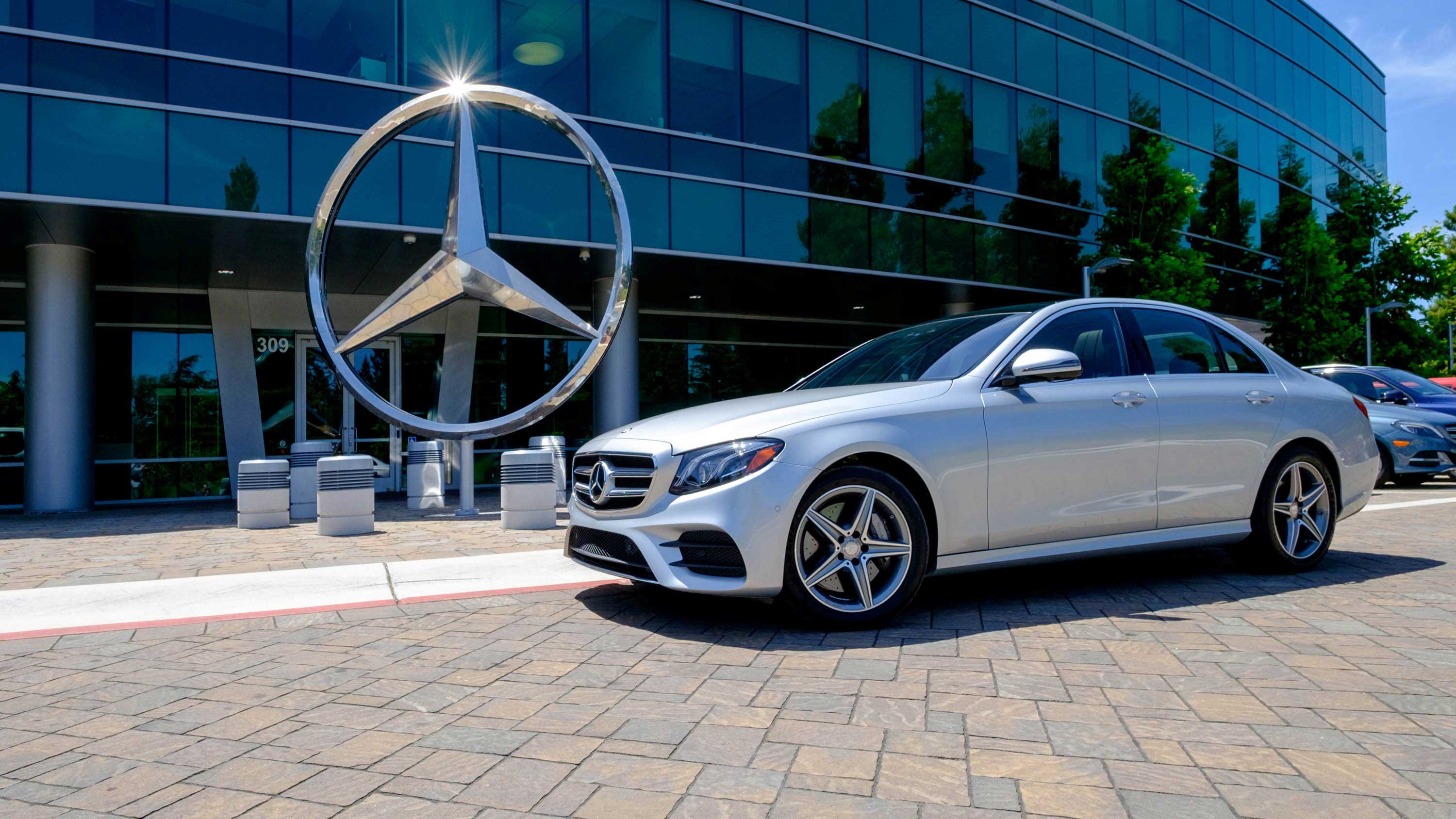
There was a time when you had to step up to a luxury marque to get all the latest gadgetry and tech, but with the democratization of technology, you see mainstream vehicles available with driver assist technologies like steering assist and full-speed adaptive cruise control systems. So what is a luxury brand like Mercedes-Benz to do when the line between mainstream and luxury becomes thinner?
Meet the new 2017 E300, the most technologically advanced car to come out of Mercedes-Benz and my new benchmark to beat for luxury vehicles. The 2017 E300 is packed to the gills with technology that makes its more extravagant sibling – the S-class - whimper with jealousy.
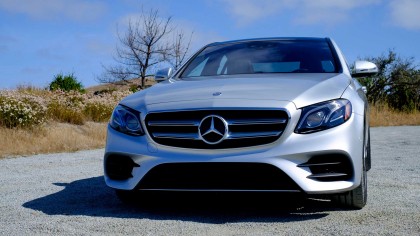
At first glance, the E300 looks like a minor evolution of the outgoing model, but that's OK. I believe Mercedes styling is timeless and still find previous generations just as beautiful as the latest and greatest. The reserved lines and subtle designs let Mercedes vehicles age gracefully with class.
Mercedes' latest E300 makes LED headlights and taillights standard across the range, which light up the road as bright as day. The adaptive LED lights can dim individual LEDs to reduce glare to other cars on the road.
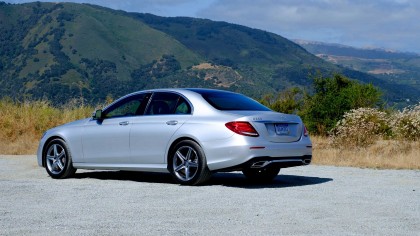
There's two different styling packages available – sport and luxury – each with its own unique visual treatments. The sport styling is easily recognized by the two-bar grille with large Mercedes star, while the luxury look has a three-bar grille with a standing star on the hood. Front fascias are completely different between the sport and luxury stylings, too.
I find the new E300 very attractive, but is the technology and how it drives any good? To find out, I packed my bags and hopped a flight to northern California to let Mercedes' latest Drive Pilot technology semi-autonomously drive me through Salinas, Pebble Beach and Carmel Valley in maximum comfort with wonderful massaging seats.
A luxurious interior
The previous generation was the oldest model in the Mercedes lineup, initially released in 2009 as a 2010 model year vehicle. Seven years old may seem normal for a luxury car product cycle, but it's the difference between an iPhone 3GS and the iPhone 6S in the rapid tech world.
Sign up for breaking news, reviews, opinion, top tech deals, and more.

Fortunately, the latest E300 ditches the previous generation's excessive use of physical buttons, including the number pad that reminds me of texting in high school on a Nokia 5190. New to the E300 is a simplified interior that minimizes the amount of physical buttons in exchange for touch pads, a control knob and handwriting recognition.
Optional real wood trim adorns the soft-touch dash and gratuitous leather treatments to create an interior worthy of a luxury car. Even the window switches have a higher-quality feel and click than your mainstream cars.

The active multi-contour front seats are the best part of the new E300 – they're heavenly. There's adjustable side bolsters that let you choose between wide and loose to a tight bear hug, so it feels like the E300 is hugging you every time you push-to-start.
In addition to free hugs from the car, there's the delightful massage function. It's a subtle effect that runs for about 12 minutes before automatically shutting off, but it helped work out the tension in my shoulders and lower back as I aggressively hammered through the windy roads.
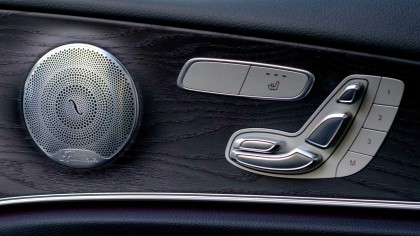
But that's not all; the E300 side bolsters actively adjust to match your aggressive driving. Say you're aggressively following a racing line and clipping apexes like a pro. The side bolsters increase support to the opposite side to keep you planted in the seat.
The seats are amazing, and I wish Mercedes sold them as desk chairs, powered and all.
New infotainment system
Mercedes provided a glimpse of the latest infotainment system at CES 2016, and I found the new infotainment system much easier to navigate and less clunky than the previous generation E-class. My opinion of the infotainment system remains the same after using it in the new E300 itself.
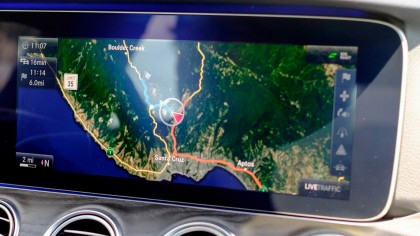
Navigation with a 12.3-inch screen is standard on all E300's. The 1920 x 720 resolution display is sharp and looks excellent from the driver's seat.
The maps are very detailed with 3D-building renderings when zoomed in and Google Earth views. However, the Google Earth overlays are only available with distant views, not close-ups, unlike the Audi TT virtual cockpit.
Mercedes provides three years of free map updates, which covers your typical lease periods.
The E300 has three control methods for the infotainment system – steering wheel mounted touchpad, control knob and touchpad with handwriting recognition. Basic volume, mute, voice recognition and phone functions have dedicated steering wheel buttons.
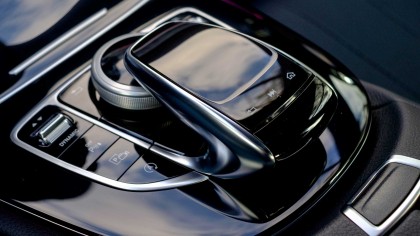
I really like control knobs for ergonomics and physical feedback. It's placed in the center console so you can sit comfortably in the driver's seat with your elbow resting on the armrest. A touchpad hovers over the control knob and lets you control the infotainment system with swipes, clicks and handwriting recognition. However, I prefer the physical feedback of rotating a knob than gestures.
The touchpad on the steering wheel takes some time to get used to. It's ergonomically excellent if you grip the steering wheel with both hands and responded quickly to my thumbs. Functionality is the same as the center console-mounted controls, but I found my arm drifting towards the control knob during most of my drive.

When I did grip the steering wheel with both hands, I was focused on enjoying the road ahead more than trying to use the infotainment system.
While Mercedes includes excellent physical control methods, the user interface still needs work. You still have to click through multiple sub-menus to set a radio preset, browse your music or set a destination.
Android Auto and Apple CarPlay to the rescue
Android Auto and Apple CarPlay are supported on the gorgeous 1920 x 720 resolution screen. Apple CarPlay stretches to fill out the screen entirely and looks comically large with massive icon spacing on the E300 screen, but Android Auto shows up in a smaller 16:9 area of the display with a static black box that fills in the unoccupied areas.
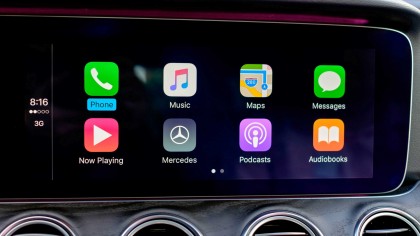
Both smartphone connectivity options translate well to the control knob, but left me with the desire to touch the screen. Apple and Google's car interfaces are designed for touchscreens, so while the control knob works, it's not ideal.
Unfortunately, the steering wheel touchpad doesn't work with Android Auto or Apple CarPlay, so you have to rely on the control knob for input. However, handwriting recognition works using the touchpad for search functions.
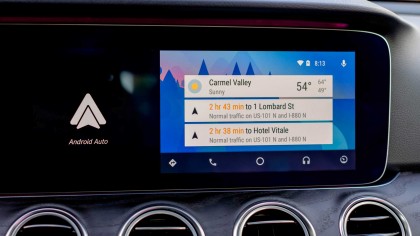
For Android Auto, you must have Google handwriting recognition installed on your phone for it to work.
When the infotainment system is running Apple CarPlay or Android Auto, it disables the onboard navigation and relies on Apple or Google Maps. Engaging Siri or Google Now voice recognition still requires a long press on the voice recognition button, unfortunately.

Overall, Android Auto and Apple CarPlay works well enough in the E300, but I wouldn't rely on it for the first three years because the stretched view doesn't look as pretty as the native interface and maps. When the onboard navigation maps are outdated and you're past the free update period, then it's time to switch over to the phone, unless you really depend on Google Now.
Otherwise, the stretched out Apple CarPlay and left-over screen space left by Android Auto is a waste on the E300's crisp display.
Optional LCD gauge cluster
Analog gauges are standard on the E300, but you can opt to replace the gauges with a 12.3-inch display with slick graphics and customizable layouts. I drove vehicles with analog and LCD gauge clusters and preferred the dual LCD setup.
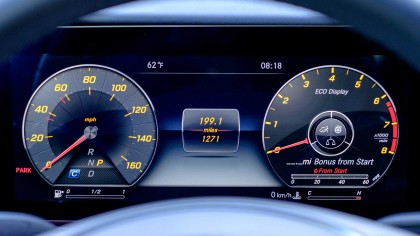
While I'm a fan of analog gauges for its response and visual depth, it looks out of place in the Mercedes E300 due to the adjacent infotainment display. Opting for the LCD gauge cluster gives it a cohesive appearance.
The piano black bezels and ambient lighting gives the dashboard a futuristic floating display feel, which looks fantastic.
Mercedes provides three different gauge cluster designs: classic, sport and progressive. Classic and sport designs have digitally rendered round gauges that look flat and don't do the high-resolution LCD justice. The sport design changes the color scheme to a sportier yellow color scheme, but has the same design otherwise.
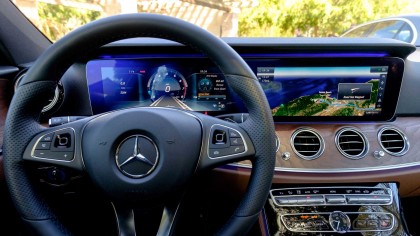
Progressive is Mercedes' take on a modern gauge cluster interface with a single analog tachometer with digital speedometer in the center. Drivers are free to configure the adjacent display areas with information such as navigation, music, trip information, fuel economy and more.
I started out with the sport gauges and found myself leaning towards progressive. The modern styling with the ability to show turn-by-turn navigation directions was useful, especially while my driving partner was being the DJ using the infotainment display.
Get the head-up display
Head-up displays (HUD) are one of the best features of a luxury car, and the E300 does it right. Mercedes employs a color HUD which projects your speedometer, clock, navigation and driver assist information onto the windshield.
I love having that information directly in my field of view so I don't have to take my eyes off the road to glance down at the gauge cluster. The only thing lacking from the Mercedes E300 HUD is the option for a tachometer and gear position display when using the paddle shifters.
Drive Pilot is wonderful
Mercedes Distronic Plus is one of the few driver's assist systems I completely trust to take my hands off the wheel if I want to briefly devour a succulent Big Mac from McDonald's (I can't resist the 2-for-$5 deal). It's a reliable system that follows lane markers at all speeds.

Drive Pilot takes things up a notch to provide highway autonomous driving, including full-speed adaptive cruise control (ACC), lane keep assist (LKAS) and lane change assist (LCA). Heck, the E300 is equipped with the same hardware as Mercedes' completely autonomous (by Nevada law), albeit with different software.
Driving the Drive Pilot system are radar sensors that can read up to 250m ahead and 80m behind the car. A stereoscopic 3D camera reads the road and vehicles ahead up to 70m away while a 2D camera boosts the visual capabilities up to 90m.
To engage the full highway autonomous capabilities of the E300's Drive Pilot system, there's one specific setting in the vehicle configuration screen you must change – the LKAS mode. All the E300s on hand were set to "adaptive," which works with user input without being intrusive. The adaptive setting will wait until the car drifts towards the lane marker before intervening.
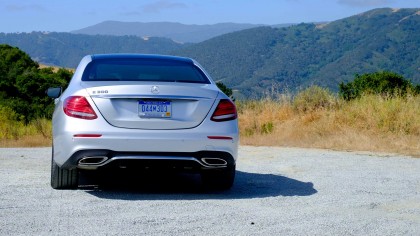
Changing it to "standard" lets the system keep the E300 centered in the lane without your help. Combine that with the full-speed ACC and the E300 operates semi-autonomously at speeds up to 100 mph.
There is one little caveat, however. The E300 gets angry and flashes warning messages on the head-up display (HUD) and LCD gauge cluster to warn you to keep your hands on the wheel, so it still expects some steering input to protect Mercedes from litigation.
I engaged Drive Pilot during many parts of my drive and found it excellent and reliable on well-marked roads. There was a stretch of road under construction that was problematic for the LKAS, but that's understandable because the roads had temporary lane markers that commuters even had trouble following.

When the road curves too much, Drive Pilot has trouble keeping the car centered, but it's the perfect time to engage the E300's Sport+ driving mode and take the wheel and use the available paddle shifters.
Drive Pilot's LCA system is a very cool feature – drive above 50 mph but below 100 mph, put the turn signal on and it'll scan the vehicle's surroundings before changing into the adjacent lane without driver intervention. It's a neat feature that I enjoyed testing out, but I'm not sure it's something I'd use after the initial wow factor wore off.
Don't get me wrong, it's cool to simply put on the turn signal and watch the car change lanes itself, but I'm a little old fashioned and can change lanes myself using the blind spot monitor (BSM). However, judging by the amount of other drivers I encounter that struggle to check their blind spots for lane change maneuvers, highways would be a safer place if all cars had LCA technology.
Drive Pilot can read speed limit signs and adjust the ACC accordingly, too. You can disable the feature via the infotainment system if you prefer to drive at your own pace, however.
One of the safest vehicles on the road
Mercedes touts its focus on safety with the new E300, so it does have automatic emergency braking (AEB), which automatically attempts to stop the car if it detects an imminent collision with a vehicle or pedestrian. I was unable to experience this feature because no fellow journalist or Mercedes representative was willing to jump in front of a moving E300 to test it out, understandably.

If a situation arises where you attempt to swerve to avoid another car or person, the E300 has a swerve assist function that increases the amount of steering torque at a greater ratio than you're moving the steering wheel to help you get out of the way quicker. In case there's an inanimate object or other vehicle at your swerved trajectory, the AEB can automatically stop the car as well.
The coolest safety function of the E300 is the optional Pre-Safe impulse side function. If the car detects a side impact is imminent and unavoidable, it uses the active seat bolsters to push the front seat occupant about 3-inches so your body is already moving prior to impact.
Theoretically, this reduces the amount of injury since you're further away from the point of impact, but it also lessens the impact force on your body since it's already in motion.
Rounding out the safety features is Pre-Safe sound, which plays pink-noise to prepare your ears for the sound of impact. Think of Pre-Safe sound as the car automatically cranking up the noise cancelling capabilities of your Bose QuietComfort 35 headphones prior to impact to reduce the loud noises of mangling metal your ears can perceive.
Car-to-X ready
Mercedes is jumping the gun and making the E300 the first car to ship with car-2-x communications hardware installed, but not enabled. An over-the-air (OTA) software update is coming at a later date to enable the feature.
I look forward to a car-to-x future where in-dash traffic reports are quicker to report accidents, congestion and road hazards. Sure, there's SiriusXM and HD Radio traffic data, but those aren't quite as real-time as a car detecting a problem and broadcasting it to all other vehicles on the road.
Performance
Mercedes launched the new E-class with a single powertrain - the 2.0-liter turbocharged four cylinder mated to a 9-speed automatic transmission powering the E300. More power-hungry drivers need not worry, however, because the biturbo V6-packing E400 is coming next year, as will AMG versions.
The E300 claims a 0-60 time of 6.2 seconds, which isn't too shabby from the 241 horsepower mill. I found the 273 lb-ft of torque starting at a low 1,300 RPM enjoyable to drive with just the right amount of power for putting around town and cruising on the highway.
Passing power is adequate, but I'd like a little more considering the typical flow of traffic on a moving California highway is 80 mph. The automatic transmission is the best 9-speed implementation I've driven with its buttery-smooth shifts.
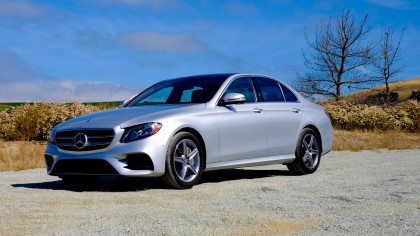
My previous experience with Mercedes' 9-speed was in the GLC300 where comfort mode was excellent but sport mode was harsh and clunky. I'm happy to report the tuning in the E300 doesn't have the same problem in sport mode.
Mercedes outfits every E300 with selective damping suspension that lets you select the damping for your comfort or sporting driving habits. Luxury and sport trim levels have different suspension, with the sport sitting lower than the luxury – air suspension is optional.
I only drove the sport trim levels with the standard and optional air suspension. The standard sport suspension is excellent - it lets you feel the road through the steering wheel without sacrificing comfort. I felt confident driving the E300 through California's curvaceous back roads and always felt in control.
The air suspension left me conflicted. While cruising down the road, it felt like I was riding in a cloud of luxury, but hammer on the throttle, start pushing on the car and it responds like a sport sedan should. It does let you have your cake and eat it, too, but I'm the type of person that just wants to eat cake, so I'd stick to the regular sport suspension.
I don't want to feel like I'm floating on a cloud like Lakitu, but maybe when I'm older, my mind will change.
What we liked
The Mercedes E300 is a wonderful technology showcase of what to expect from mainstream cars in the next decade. There's plenty to like about it, like Drive Pilot, the HUD, LCD gauge cluster, real wood interior trim, enhanced safety features, driving dynamics and sharp styling.
It's the type of vehicle you can relax in and let Drive Pilot take over the mundane task of commuting while you sit back and enjoy the massaging seats. When it's time for a weekend getaway, you can release some of that pent up commuting aggression by enjoying yourself on windy back roads.
What we didn't
Mercedes gets a lot right, but the Android Auto interface not occupying the entire 21:9 ratio display is distracting. There's simply a large black box that says "Android Auto" to fill in the empty space that feels like they couldn't get it to stretch the full width and gave up. Mercedes could've enabled a split-screen display mode that showed music information, fuel economy data or anything else, really, next to the Android Auto display.
The same could be said about Apple CarPlay. Despite occupying the complete width, the user interface doesn't lend itself well to 21:9 aspect ratios. It just looks comically large. A 16:9 CarPlay display with additional vehicle information next to it would've been a better use of space.
Mercedes steering wheel mounted touchpad is an excellent control interface, but it doesn't work with Android Auto or Apple CarPlay. I'd like to see Mercedes tweak the software to enable this, otherwise you're stuck with the control knob as the sole interface for Android Auto and Apple CarPlay.
My last quibble is a personal preference, but I don't like Mercedes' column shifter. It's an electronic shifter that's nothing like the old cable-based ones of previous era vehicles, but I can't help but be reminded of driving my mom's 1993 Dodge Grand Caravan, the car I learned to drive with, every time I shifted into drive or reverse.
The competition
Mercedes has a lot of competition for the E300, like the Audi A6, BMW 528i, Cadillac CTS, Genesis G80 (formerly the Hyundai Genesis sedan), Infiniti Q70, Lexus GS350 and Tesla Model S. However, none of the competition is on the same level as Mercedes when it comes to driver assist technologies, except Tesla's Autopilot.
But I wouldn't consider the Model S a luxury vehicle. It may have phenomenal straight line performance, but simply sitting inside it reveals its dreadful interior, even with the premium interior package. The Mercedes E300 has a cockpit you don't want to get out of, and that's what owning a luxury car is about – comfort.
Volvo's new S90 sedan shows promise with its gorgeous looks and Pilot Assist II driver assist technology, but I haven't driven it yet and am reserving judgment.
Final verdict
The Mercedes E300 is my top choice for a luxury sedan if I were shopping for a car that eases my daily commute, but is still enjoyable to drive on the weekends. It has better driver assist technology than the range-topping S-class, but sports the same classy design language.
Inside, the optional dual LCD's and real wood trim look techy, yet classy at the same time. The active multi-contour seats are absolutely heavenly and I wish every car had it, because side bolsters that shift to help keep you in your seat are an amazing feeling.
Android Auto and Apple CarPlay support ensure the E300's infotainment system isn't too dated after the typical three-year lease periods – just plug your phone in and you won't have to pay for map updates.
Ultimately, if I had the money to spend on a luxury sedan, I'd grab an E-class because Mercedes' Drive Pilot is reliable and the interior is a pleasant and welcoming place to be.
I'd skip the E300 and go straight to the upcoming E400, though. I found the E300's performance adequate for commuting and having fun, however, the E400 is the only way to get the E-class as a station wagon in the US, and I have a strong affinity for station wagons.